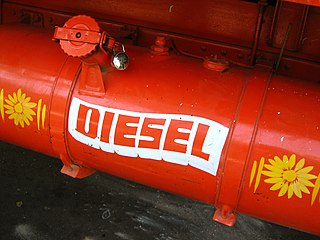
Benzoic acid is a white (or colorless) solid with the formula C6H5CO2H. It is the simplest aromatic carboxylic acid. The name is derived from gum benzoin, which was for a long time its only source. Benzoic acid occurs naturally in many plants and serves as an intermediate in the biosynthesis of many secondary metabolites. Salts of benzoic acid are used as food preservatives. Benzoic acid is an important precursor for the industrial synthesis of many other organic substances. The salts and esters of benzoic acid are known as benzoates.

In chemistry, particularly in biochemistry, a fatty acid is a carboxylic acid with a long aliphatic chain, which is either saturated or unsaturated. Most naturally occurring fatty acids have an unbranched chain of an even number of carbon atoms, from 4 to 28. Fatty acids are usually not found in organisms, but instead as three main classes of esters: triglycerides, phospholipids, and cholesteryl esters. In any of these forms, fatty acids are both important dietary sources of fuel for animals and they are important structural components for cells.
Methanol, also known as methyl alcohol amongst other names, is a chemical with the formula CH3OH (a methyl group linked to a hydroxyl group, often abbreviated MeOH). It is a light, volatile, colourless, flammable liquid with a distinctive alcoholic odour similar to that of ethanol (drinking alcohol). A polar solvent, methanol acquired the name wood alcohol because it was once produced chiefly by the destructive distillation of wood. Today, methanol is mainly produced industrially by hydrogenation of carbon monoxide.

Diesel fuel in general is any liquid fuel used in diesel engines, whose fuel ignition takes place, without any spark, as a result of compression of the inlet air mixture and then injection of fuel. Diesel engines have found broad use as a result of higher thermodynamic efficiency and thus fuel efficiency. This is particularly noted where diesel engines are run at part-load; as their air supply is not throttled as in a petrol engine, their efficiency still remains very high.

A biofuel is a fuel that is produced through contemporary processes from biomass, rather than a fuel produced by the very slow geological processes involved in the formation of fossil fuels, such as oil. Since biomass technically can be used as a fuel directly, some people use the terms biomass and biofuel interchangeably. More often than not, however, the word biomass simply denotes the biological raw material the fuel is made of, or some form of thermally/chemically altered solid end product, like torrefied pellets or briquettes. The word biofuel is usually reserved for liquid or gaseous fuels, used for transportation. The U.S. Energy Information Administration (EIA) follows this naming practice. If the biomass used in the production of biofuel can regrow quickly, the fuel is generally considered to be a form of renewable energy.

Biodiesel is a form of diesel fuel derived from plants or animals and consisting of long-chain fatty acid esters. It is typically made by chemically reacting lipids such as animal fat (tallow), soybean oil, or some other vegetable oil with an alcohol, producing a methyl, ethyl or propyl ester.

Butyric acid (from Ancient Greek: βούτῡρον, meaning "butter"), also known under the systematic name butanoic acid is a carboxylic acid with the structural formula CH3CH2CH2CO2H. Classified as a carboxylic acid, it is an oily, colorless liquid that is soluble in water, ethanol, and ether. Isobutyric acid (2-methylpropanoic acid) is an isomer. Salts and esters of butyric acid are known as butyrates or butanoates. The acid does not occur widely in nature, but its esters are widespread. It is a common industrial chemical.

Butyrate or butanoate is the traditional name for the conjugate base of butyric acid. The formula of the butyrate ion is C
4H
7O−
2. The name is used as part of the name of esters and salts of butyric acid
Biodiesel production is the process of producing the biofuel, biodiesel, through the chemical reactions of transesterification and esterification. This involves vegetable or animal fats and oils being reacted with short-chain alcohols. The alcohols used should be of low molecular weight. Ethanol is the most used because of its low cost, however, greater conversions into biodiesel can be reached using methanol. Although the transesterification reaction can be catalyzed by either acids or bases, the base-catalyzed reaction is more common. This path has lower reaction times and catalyst cost than those acid catalysis. However, alkaline catalysis has the disadvantage of high sensitivity to both water and free fatty acids present in the oils.

Ethyl butyrate, also known as ethyl butanoate, or butyric ether, is an ester with the chemical formula CH3CH2CH2COOCH2CH3. It is soluble in propylene glycol, paraffin oil, and kerosene. It has a fruity odor, similar to pineapple, and is a key ingredient used as a flavor enhancer in processed orange juices. It also occurs naturally in many fruits, albeit at lower concentrations.

Methyl salicylate (oil of wintergreen or wintergreen oil) is an organic compound with the formula C6H4(OH)(CO2CH3). It is the methyl ester of salicylic acid. It is a colorless, viscous liquid with a sweet, fruity odor reminiscent of root beer, but often associatively called "minty," as it is an ingredient in mint candies. It is produced by many species of plants, particularly wintergreens. It is also produced synthetically, used as a fragrance, in foods and beverages, and in liniments.
Cetane number is an indicator of the combustion speed of diesel fuel and compression needed for ignition. It plays a similar role for diesel as octane rating does for gasoline. The CN is an important factor in determining the quality of diesel fuel, but not the only one; other measurements of diesel fuel's quality include energy content, density, lubricity, cold-flow properties and sulphur content.

Methyl acetate, also known as MeOAc, acetic acid methyl ester or methyl ethanoate, is a carboxylate ester with the formula CH3COOCH3. It is a flammable liquid with a characteristically pleasant smell reminiscent of some glues and nail polish removers. Methyl acetate is occasionally used as a solvent, being weakly polar and lipophilic, but its close relative ethyl acetate is a more common solvent being less toxic and less soluble in water. Methyl acetate has a solubility of 25% in water at room temperature. At elevated temperature its solubility in water is much higher. Methyl acetate is not stable in the presence of strong aqueous bases or aqueous acids. Methyl acetate is not considered as a VOC in the USA.
Pongamia oil is derived from the seeds of the Millettia pinnata tree, which is native to tropical and temperate Asia. Millettia pinnata, also known as Pongamia pinnata or Pongamia glabra, is common throughout Asia and thus has many different names in different languages, many of which have come to be used in English to describe the seed oil derived from M. pinnata; Pongamia is often used as the generic name for the tree and is derived from the genus the tree was originally placed in. Other names for this oil include honge oil, kanuga oil, karanja oil, and pungai oil.

Fatty acid esters (FAEs) are a type of ester that result from the combination of a fatty acid with an alcohol. When the alcohol component is glycerol, the fatty acid esters produced can be monoglycerides, diglycerides, or triglycerides. Dietary fats are chemically triglycerides.
Winterization of oil is a process that uses a solvent and cold temperatures to separate lipids and other desired oil compounds from waxes. Winterization is a type of fractionation, the general process of separating the triglycerides found in fats and oils, using the difference in their melting points, solubility, and volatility.
LS-9 Inc was a venture-funded company focused on producing diesel fuel from transgenic organisms. It launched in 2005, took in $81 million in investment, and in 2013 was sold to Renewable Energy Group for $40 million in cash and stock, and an additional $21.5 million if technology and production milestones were met.
The environmental impact of biodiesel is diverse.
Fuel surrogates are mixtures of one or more simple fuels that are designed to emulate either the physical properties or combustion properties of a more complex fuel. While surrogate mixtures can demonstrate more than one characteristic of the desired fuel, more often than not different components are required in order to emulate the wide variety of properties that are of interest to researchers. Jet fuel is an example of a fuel requiring a surrogate for experimental research and numerical modelling due to its complexity and high content variability from one batch to the next. Neat hydrocarbon jet fuel surrogate components include decane, dodecane, methylcyclohexane, and toluene. Gasoline surrogate components include n-heptane and iso-octane. Hexadecane is a diesel surrogate component. Biodiesel surrogate components include methyl butyrate and methyl decanoate.

Rhizopus oryzae is a filamentous heterothallic microfungus that occurs as a saprotroph in soil, dung, and rotting vegetation. This species is very similar to Rhizopus stolonifer, but it can be distinguished by its smaller sporangia and air-dispersed sporangiospores. It differs from R. oligosporus and R. microsporus by its larger columellae and sporangiospores. R. oryzae is used economically in the production of the enzymes, glucoamylase and lipase, in the synthesis of organic acids, and in various fermented foods. The many strains of R. oryzae produce a wide range of enzymes such as carbohydrate digesting enzymes and polymers along with a number of organic acids, ethanol and esters giving it useful properties within the food industries, bio-diesel production, and pharmaceutical industries. It is also an opportunistic pathogen of humans causing mucormycosis.














